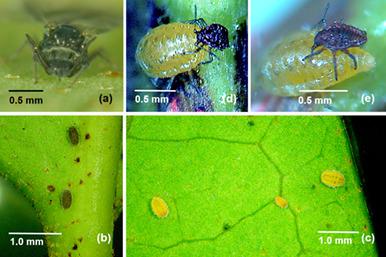当前位置:
X-MOL 学术
›
Entomol. Sci.
›
论文详情
Our official English website, www.x-mol.net, welcomes your feedback! (Note: you will need to create a separate account there.)
Reproduction site preference and performance by sexuparae, and mating behavior of their sexual generation on the primary host plant in a heteroecious aphid, Neothoracaphis yanonis (Homoptera: Aphididae)
Entomological Science ( IF 0.9 ) Pub Date : 2020-11-17 , DOI: 10.1111/ens.12451 Putu Oka Ngakan 1 , Junichi Yukawa 2
Entomological Science ( IF 0.9 ) Pub Date : 2020-11-17 , DOI: 10.1111/ens.12451 Putu Oka Ngakan 1 , Junichi Yukawa 2
Affiliation

|
We studied reproduction site preference and performance by the sexuparae (autumnal migrants) of Neothoracaphis yanonis and mating behavior of their sexual generation on its primary host plant, Distylium racemosum. The sexuparae preferred younger leaves of D. racemosum for settlement and imbibing leaf sap, and they produced more offspring there than on older leaves. Thus, it is suggested that the sexuparae selected more nutritious younger leaves to increase their own fecundity. The offspring consist of yellowish dark‐grey and creamy yellow type nymphs, which develop into small males and large oviparae, respectively. Yellowish dark‐grey nymphs were deposited gregariously on the basal part of the abaxial surface of a leaf blade, while creamy yellow nymphs were deposited evenly over the abaxial surface. Such a localized distribution pattern probably resulted from sexuparae's strategy to enhance a possibility for their male offspring to mate with oviparae at the base of leaf blade, over which oviparae crawl to twigs. During mating and sometimes afterwards, the ovipara incidentally carried a male on her back and crawled downward on twig to find an axillary bud for oviposition. This behavior may be advantageous to males, who can guard their mate during this period against other conspecific males. Such mate‐guarding behavior seems to be related to the development of dual mate‐seeking strategies, in which males try to copulate, first at the basal part of midrib, and second on the axillary bud.
中文翻译:

繁殖场所对性繁殖的偏好和表现,以及在异性蚜虫新实蝇(Neothoracaphis yanonis)(直翅目:蚜科)的主要寄主植物上有性繁殖的交配行为
我们以sexuparae的(秋季移民)研究复制站点首选项和性能Neothoracaphis yanonis和他们有性世代对其主要寄主植物,交配行为蚊母树蔓。的sexuparae首选幼叶D.蔓用来吸收和吸收叶汁,它们在那里产生的后代比在老叶子上产生的更多。因此,建议性繁殖选择更多营养的年轻叶片以增加自身的繁殖力。其后代由淡黄色的暗灰色和乳黄色的若虫组成,它们分别发育成小雄性和大卵形。淡黄色的暗灰色若虫聚集在叶片的背面的基部,而乳白色的黄色若虫均匀地沉积在叶片的背面。这种局部分布的模式可能是由于sexuparae的策略提高了其雄性后代在叶片基部与卵形卵交配的可能性,卵形卵爬过树枝。在交配期间,有时甚至在之后 输卵管顺带一个雄性在她的背上,并在树枝上向下爬行,以找到一个用于排卵的腋芽。这种行为对于雄性可能是有利的,雄性可以在此期间保护自己的配偶免受其他同种雄性的侵害。这种保护伴侣的行为似乎与双重寻求伴侣策略的发展有关,在这种策略中,雄性试图交配,首先是在中肋的基部,然后是在腋芽上。
更新日期:2020-11-17
中文翻译:

繁殖场所对性繁殖的偏好和表现,以及在异性蚜虫新实蝇(Neothoracaphis yanonis)(直翅目:蚜科)的主要寄主植物上有性繁殖的交配行为
我们以sexuparae的(秋季移民)研究复制站点首选项和性能Neothoracaphis yanonis和他们有性世代对其主要寄主植物,交配行为蚊母树蔓。的sexuparae首选幼叶D.蔓用来吸收和吸收叶汁,它们在那里产生的后代比在老叶子上产生的更多。因此,建议性繁殖选择更多营养的年轻叶片以增加自身的繁殖力。其后代由淡黄色的暗灰色和乳黄色的若虫组成,它们分别发育成小雄性和大卵形。淡黄色的暗灰色若虫聚集在叶片的背面的基部,而乳白色的黄色若虫均匀地沉积在叶片的背面。这种局部分布的模式可能是由于sexuparae的策略提高了其雄性后代在叶片基部与卵形卵交配的可能性,卵形卵爬过树枝。在交配期间,有时甚至在之后 输卵管顺带一个雄性在她的背上,并在树枝上向下爬行,以找到一个用于排卵的腋芽。这种行为对于雄性可能是有利的,雄性可以在此期间保护自己的配偶免受其他同种雄性的侵害。这种保护伴侣的行为似乎与双重寻求伴侣策略的发展有关,在这种策略中,雄性试图交配,首先是在中肋的基部,然后是在腋芽上。



























 京公网安备 11010802027423号
京公网安备 11010802027423号